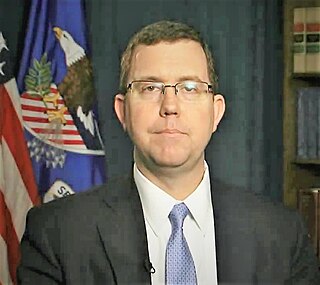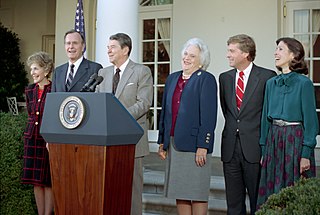
The Executive Office of the President (EOP) comprises the offices and agencies that support the work of the president at the center of the executive branch of the United States federal government. The EOP consists of several offices and agencies, such as the White House Office, the National Security Council, and the Office of Management and Budget.

The White House chief of staff is the head of the Executive Office of the President of the United States and a cabinet position, in the federal government of the United States.
In the United States, a recess appointment is an appointment by the president of a federal official when the U.S. Senate is in recess. Under the U.S. Constitution's Appointments Clause, the President is empowered to nominate, and with the advice and consent (confirmation) of the Senate, make appointments to high-level policy-making positions in federal departments, agencies, boards, and commissions, as well as to the federal judiciary. A recess appointment under Article II, Section 2, Clause 3 of the Constitution is an alternative method of appointing officials that allows the temporary filling of offices during periods when the Senate is not in session. It was anticipated that the Senate would be away for months at a time, so the ability to fill vacancies in important positions when the Senate is in recess and unavailable to provide advice and consent was deemed essential to maintain government function, as described by Alexander Hamilton in No. 67 of The Federalist Papers.

Llewelyn Sherman Adams was an American businessman and politician, best known as White House Chief of Staff for President Dwight D. Eisenhower, the culmination of an 18-year political career that also included a stint as the 67th governor of New Hampshire. He lost his White House position in a scandal when he accepted an expensive vicuña coat.

The White House counsel is a senior staff appointee of the president of the United States whose role is to advise the president on all legal issues concerning the president and their administration. The White House counsel also oversees the Office of White House Counsel, a team of lawyers and support staff who provide legal guidance for the president and the White House Office.

United States Government Policy and Supporting Positions is a book that lists positions in the United States government that are subject to political appointment. It lists around 9,000 federal civil service leadership and support positions in the legislative and executive branches of the federal government that may be subject to noncompetitive appointment nationwide. It is a publication of the United States Senate's Committee on Governmental Affairs and the House of Representatives' Committee on Government Reform. A new edition is published every four years, just after each presidential election. All tenured positions commissioned by the president are published, including all officers of the United States, their immediate subordinates, policy executives and advisors, and aides who report to these officials. Some positions are kept secret and not published due to being classified via executive privilege.

The White House Office of the Executive Clerk is responsible for managing the original legal documents signed by the President of the United States which make up his official acts—these include public laws, vetoes, treaties, executive orders, signing statements, nominations, proclamations, commissions, pardons, and certificates of awards or medals. The office is further responsible for delivering any reports or messages the President wishes to send to the United States Congress. Formed in 1865, it is one of the oldest offices in the Executive Office of the President of the United States.
Henry Roemer McPhee Jr. was educated at Princeton University. During the Second World War, McPhee served as a naval officer on destroyer escorts in the Pacific.
During his two terms in office, President Dwight D. Eisenhower nominated five members for the Supreme Court of the United States: Chief Justice Earl Warren, and Associate Justices John Marshall Harlan, William Brennan, Charles Evans Whittaker, and Potter Stewart. All were confirmed by the Senate.

The nomination and confirmation of justices to the Supreme Court of the United States involves several steps, the framework for which is set forth in the United States Constitution. Specifically, Article II, Section 2, Clause 2, provides that the President of the United States nominates a justice and that the United States Senate provides Advice and consent before the person is formally appointed to the Court. It also empowers a president to temporarily, under certain circumstances, fill a Supreme Court vacancy by means of a recess appointment. The Constitution does not set any qualifications for service as a justice, thus the president may nominate any individual to serve on the Court.

Arthur Hendrick Vandenberg Jr. was a Republican government official from Michigan. He worked for many years on the staff of his father, Arthur H. Vandenberg (1884–1951), who served in the U.S. Senate from 1928 to 1951. He was briefly appointed to Eisenhower's White House staff in November 1952 but resigned in 1953 at the very start of the Eisenhower administration. He also worked as a consultant and academic and edited his father's papers for publication.

The Staff Secretary is a position in the White House Office responsible for managing paper flow to the President and circulating documents among senior staff for comment. It has been referred to as "the nerve center of the White House." Specifically, the Office of the Staff Secretary decides which decision memos, briefing materials, lists of potential nominees, briefing books, intelligence reports, schedules, correspondence, and speech drafts end up on the president’s desk, as well as how and when the president will receive them. The Staff Secretary also works with senior White House staff to edit all of these materials and ensure they are ready for the president's consumption.

The Federal Vacancies Reform Act of 1998 is a United States federal statute establishing the procedure for filling vacancies in an appointed office of an executive agency of the government before the appointment of a permanent replacement.
According to the United States Office of Government Ethics, a political appointee is "any employee who is appointed by the President, the Vice President, or agency head". As of 2016, there were around 4,000 political appointment positions which an incoming administration needs to review, and fill or confirm, of which about 1,200 require Senate confirmation. The White House Presidential Personnel Office (PPO) is one of the offices most responsible for political appointees and for assessing candidates to work at or for the White House.

The White House Presidential Personnel Office is the White House Office tasked with vetting new appointees. Its offices are on the first floor of the Eisenhower Executive Office Building in Washington, D.C. The PPO is one of the offices most responsible for assessing candidates to work at or for the White House.

The presidential transition of George H. W. Bush began when then-Vice President George H. W. Bush won the United States 1988 United States presidential election, becoming the president-elect, and ended when Bush was inaugurated at noon EST on January 20, 1989.

The presidential transition of John F. Kennedy began when John F. Kennedy won the 1960 United States presidential election, becoming the president-elect of the United States, and ended when Kennedy was inaugurated at noon EST on January 20, 1961.









